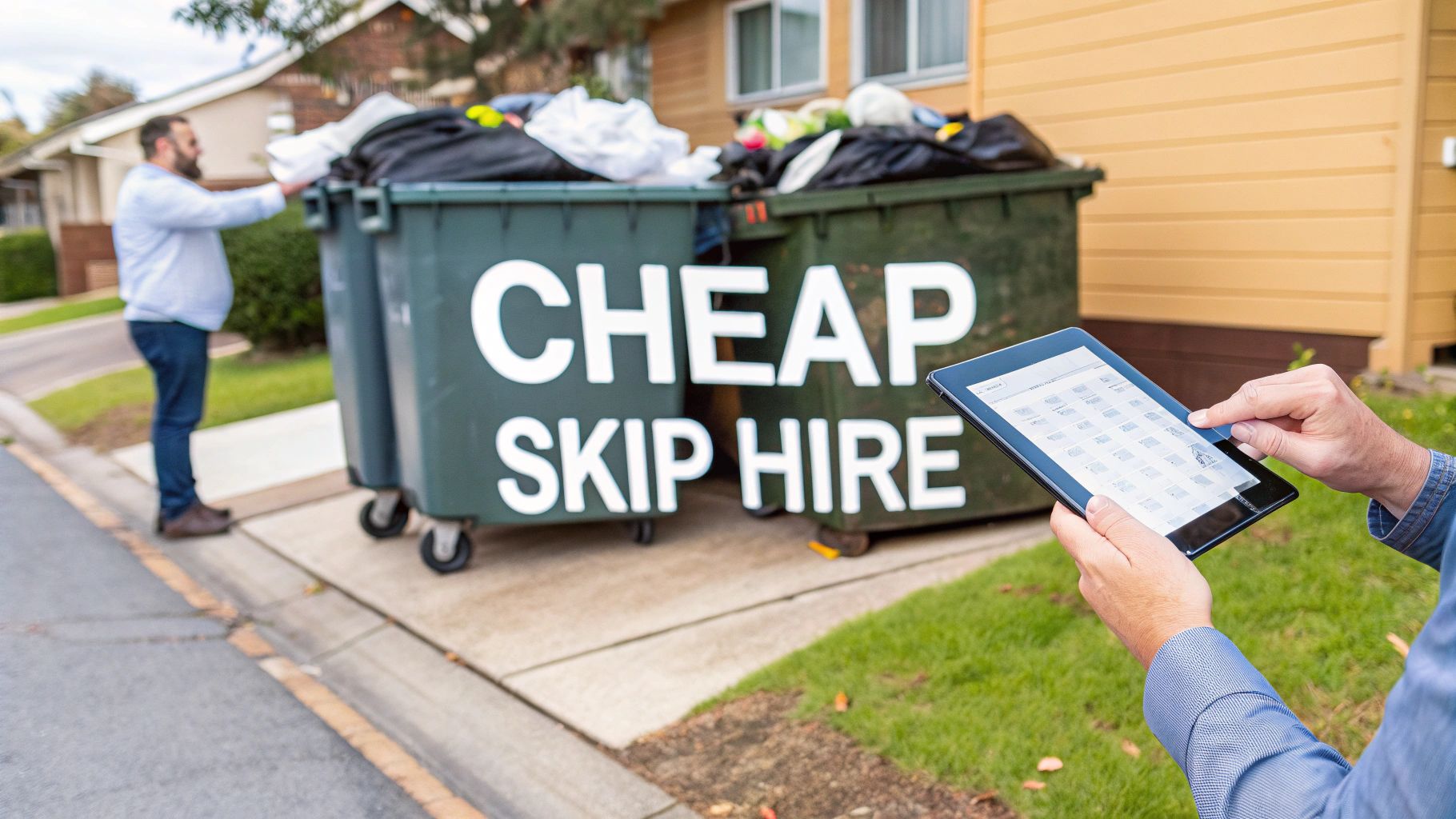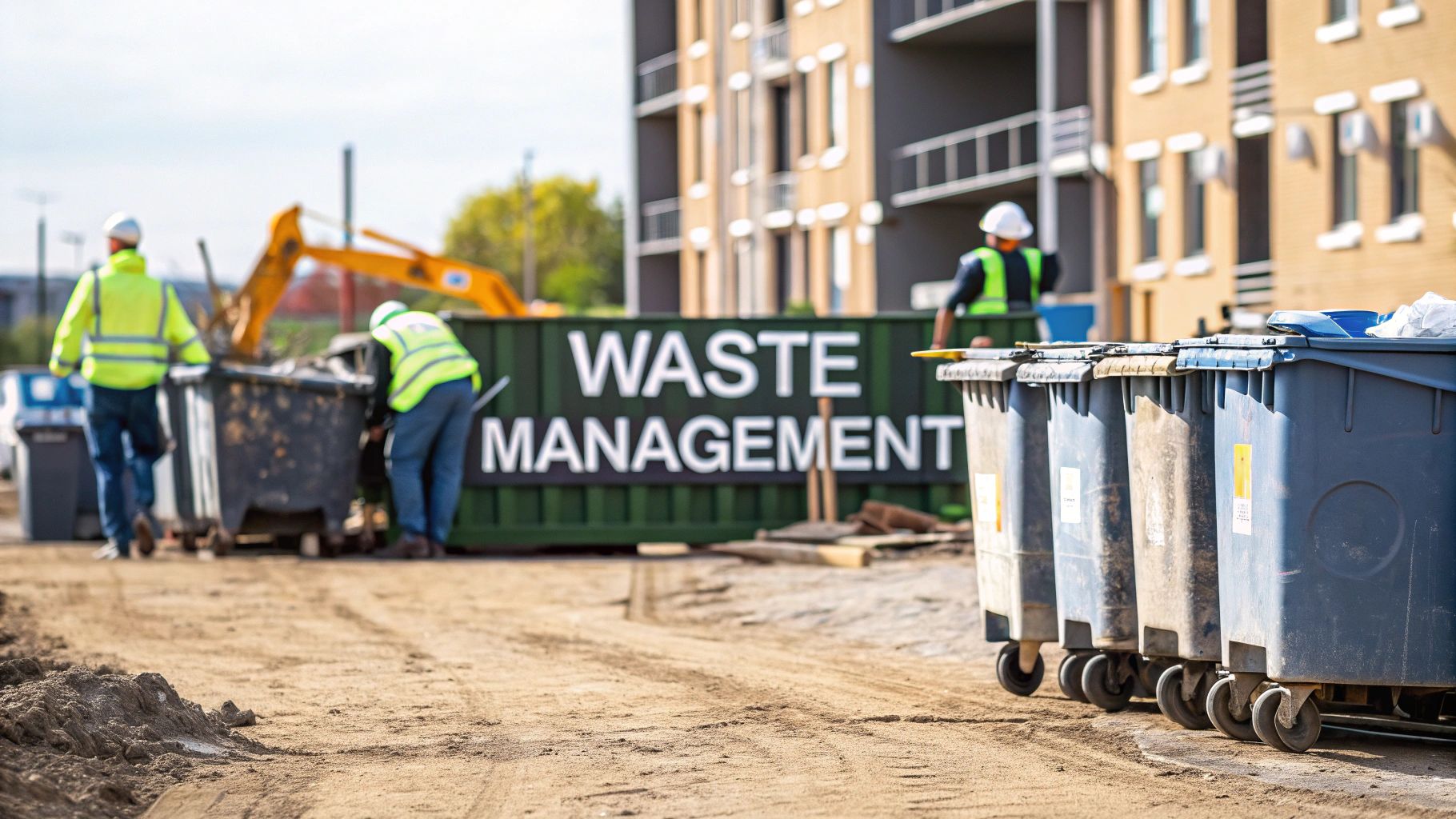How Big Is 6 Yard Skip? Find Out My Complete UK Guide
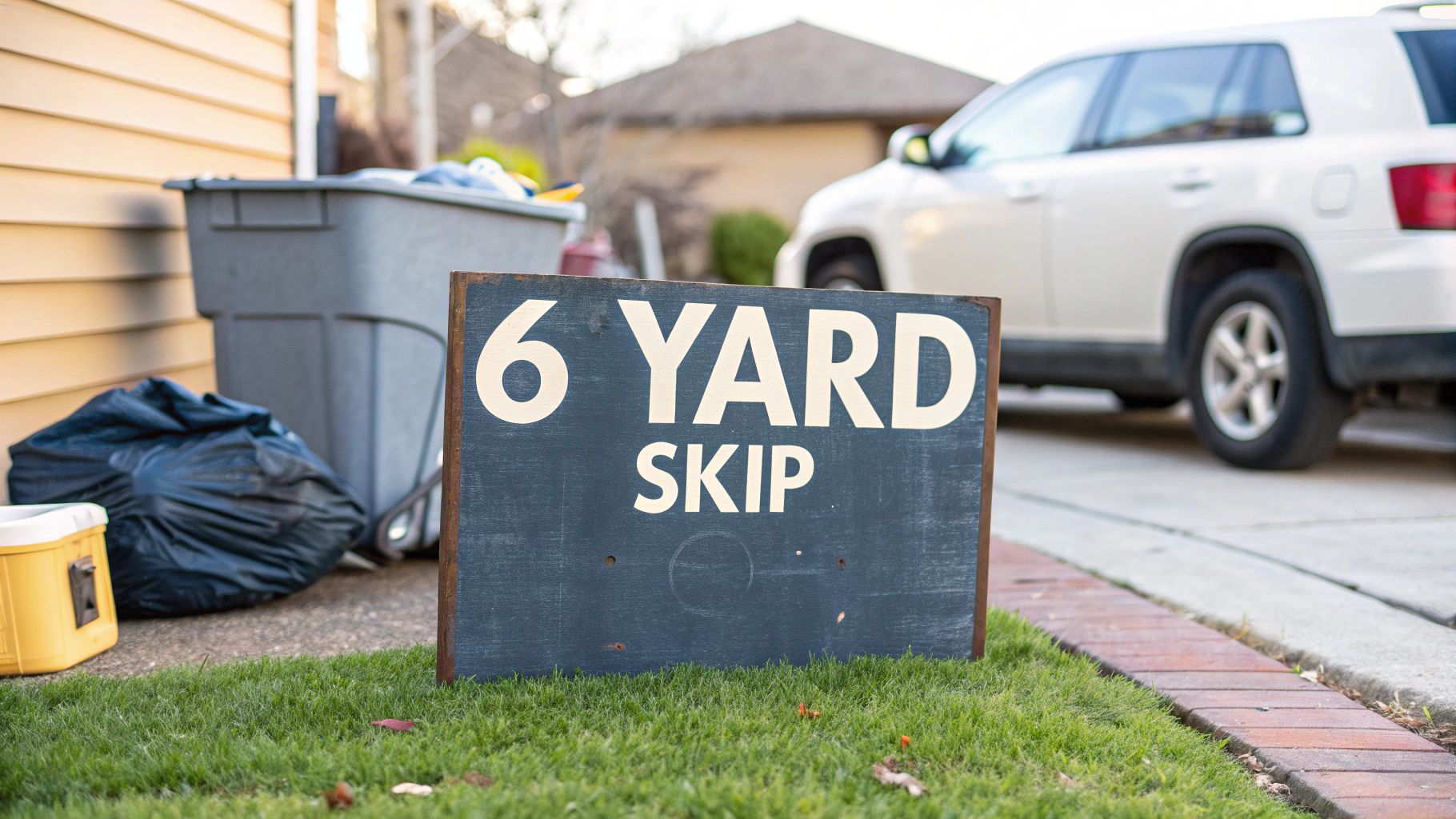
How Big Is 6 Yard Skip? Find Out My Complete UK Guide
If you’ve ever driven past a building site or a house undergoing a serious renovation, you've almost certainly seen a 6-yard skip. Often called a ‘builder’s skip’, it’s one of the most popular waste solutions in the UK, and for very good reason.
It manages to hit that perfect sweet spot between size and capacity. Big enough for hefty projects but not so huge that it takes over your entire driveway.
Your Quick Guide to the 6 Yard Skip
Trying to picture what "6 cubic yards" actually looks like can be tricky. The best way to think about it is as the go-to choice for jobs that are too big for the council bins but don't quite justify a massive industrial-sized container.
It’s this versatility that makes it a firm favourite for builders, landscapers, and homeowners alike. You get a substantial amount of space without needing a massive footprint on your property.
To get a bit more specific, a 6-yarder can hold around 60 standard black bin bags. Another way to look at it is in terms of builder's materials – you’re talking about 27 full wheelbarrow loads of waste. That’s a serious amount of room, making it ideal for everything from a complete kitchen tear-out to a major garden overhaul. If you want to see how it stacks up against other options, you can find more insights about UK skip sizes here.
To give you a clearer idea, here's what that capacity means for common projects:
- Home Clear-Outs: Easily swallows up old furniture, carpets, and all the general clutter from clearing out a medium-sized house.
- Renovation Debris: Perfect for chucking in old bathroom suites, kitchen cupboards, plasterboard, and timber.
- Garden Waste: Has plenty of room for heavy stuff like soil, broken paving slabs, rubble, and large amounts of green waste.
To break it down even further, here's a quick summary of the key details.
6 Yard Skip at a Glance
This table gives you a simple, at-a-glance overview of what you can expect from a standard 6-yard skip.
| Specification | Measurement |
|---|---|
| Capacity (Volume) | 6 Cubic Yards (Approx. 4.6 m³) |
| Height | 1.22 metres (Approx. 4 ft) |
| Length | 2.6 metres (Approx. 8.5 ft) |
| Width | 1.52 metres (Approx. 5 ft) |
| Bin Bag Capacity | 60-65 standard black bin bags |
| Wheelbarrow Loads | ~27 full wheelbarrows |
| Common Name | 'Builder's Skip' |
As you can see, its dimensions make it a practical choice for most driveways while still offering a generous volume for waste. Understanding this balance is the first step to figuring out if it’s the right fit for your job.
Visualising How a 6 Yard Skip Fits Your Space
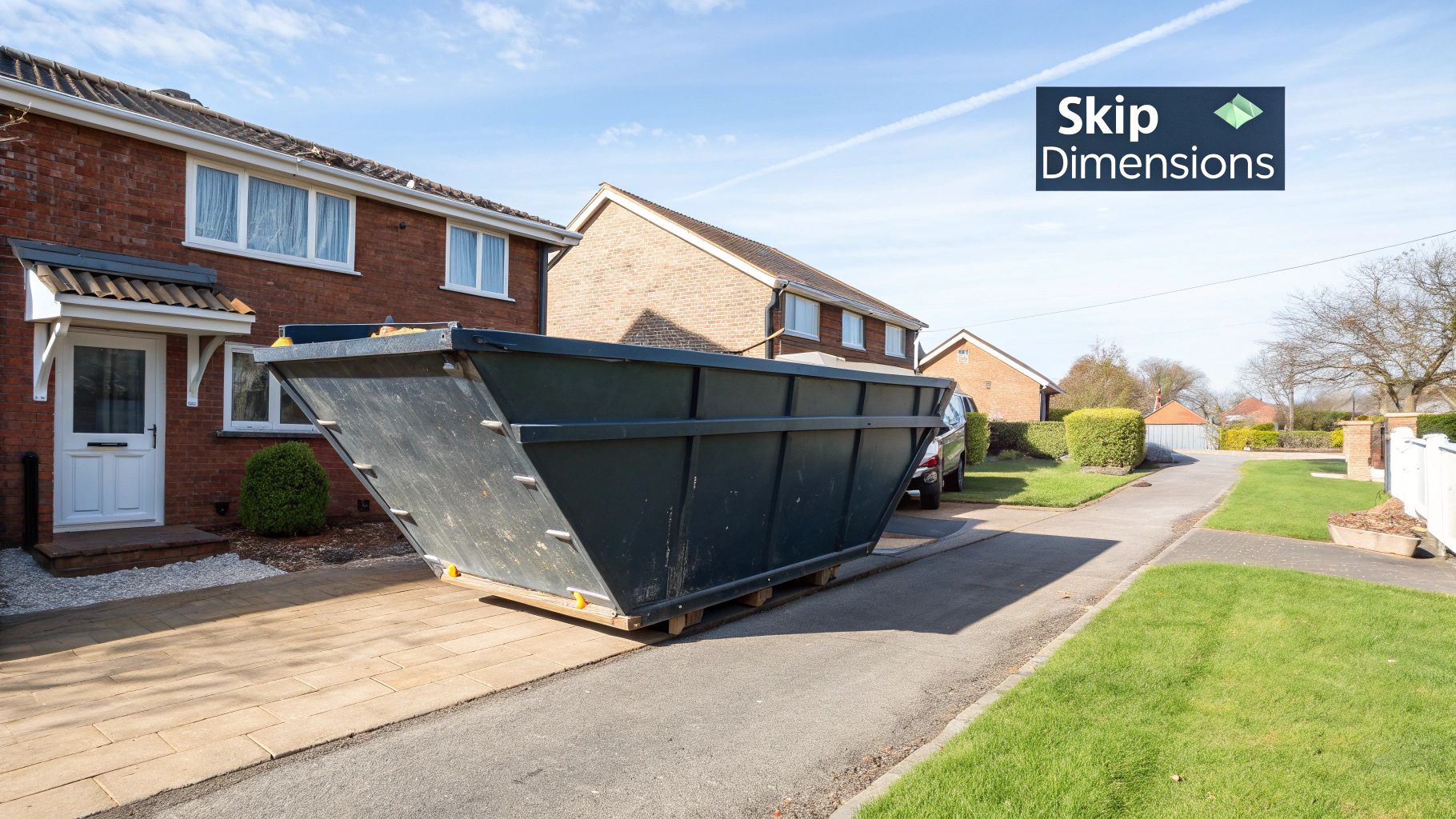
It’s one thing to see numbers on a screen, but quite another to picture a huge metal box sitting on your drive. So let's put those dimensions into perspective and answer the real question on your mind: will it actually fit?
The easiest way to get your head around its footprint is to think of a small family car. A standard 6-yard skip is about the same length as a Ford Fiesta. For most homeowners, that comparison instantly clicks, giving you a solid idea of the space it’ll take up before it even turns up.
But here’s the thing – the skip itself is only part of the equation. You also need to think about the lorry that’s delivering it.
Planning For Delivery and Placement
You can’t just measure out a spot for the skip and call it a day. The lorry needs a surprising amount of room to get in, drop the skip off, and get back out again safely. Getting this bit right is crucial for a stress-free hire.
Before you book anything, grab a tape measure and check your access route. Measure the width of your gate, your drive, and look up for any low-hanging tree branches or cables. A failed delivery because the lorry can't get in can be a costly mistake.
Here are the key things you need to have in mind:
- Driveway Width: You’ll need a driveway that’s at least 3 metres (about 10 feet) wide. This gives the delivery lorry enough space to reverse in and manoeuvre.
- Overhead Clearance: Make sure the coast is clear above. Low tree limbs, telephone wires, or roof overhangs can easily get in the way of the lorry's lifting arm.
- Ground Condition: Skips and the lorries carrying them are seriously heavy. The ground needs to be solid, like tarmac or concrete. Placing it on a soft lawn or soil will cause damage.
Figuring out these practical details is just as important as knowing how much you can cram inside the skip. If you want to explore other options, our guide that explains different skip sizes is a great place to start. A little bit of planning for placement will make sure your project gets off to a smooth start, with your skip sitting exactly where it should be – safely and legally.
Understanding What Really Fits Inside
Knowing the dimensions is one thing, but picturing what 6 cubic yards actually looks like in terms of real-world rubbish is the key to getting your skip hire right. Let's move past the numbers and get a proper feel for what a 6-yard skip can handle for common jobs.
Think about a full kitchen rip-out. This skip has plenty of room for all the old cabinets, worktops, flooring, and tiles. Or maybe you're tackling a major garden clear-out? It’ll easily swallow a mix of soil, broken paving slabs, old fencing, and green waste without any fuss.
This image gives you a great visual idea of its capacity for mixed household and garden waste.
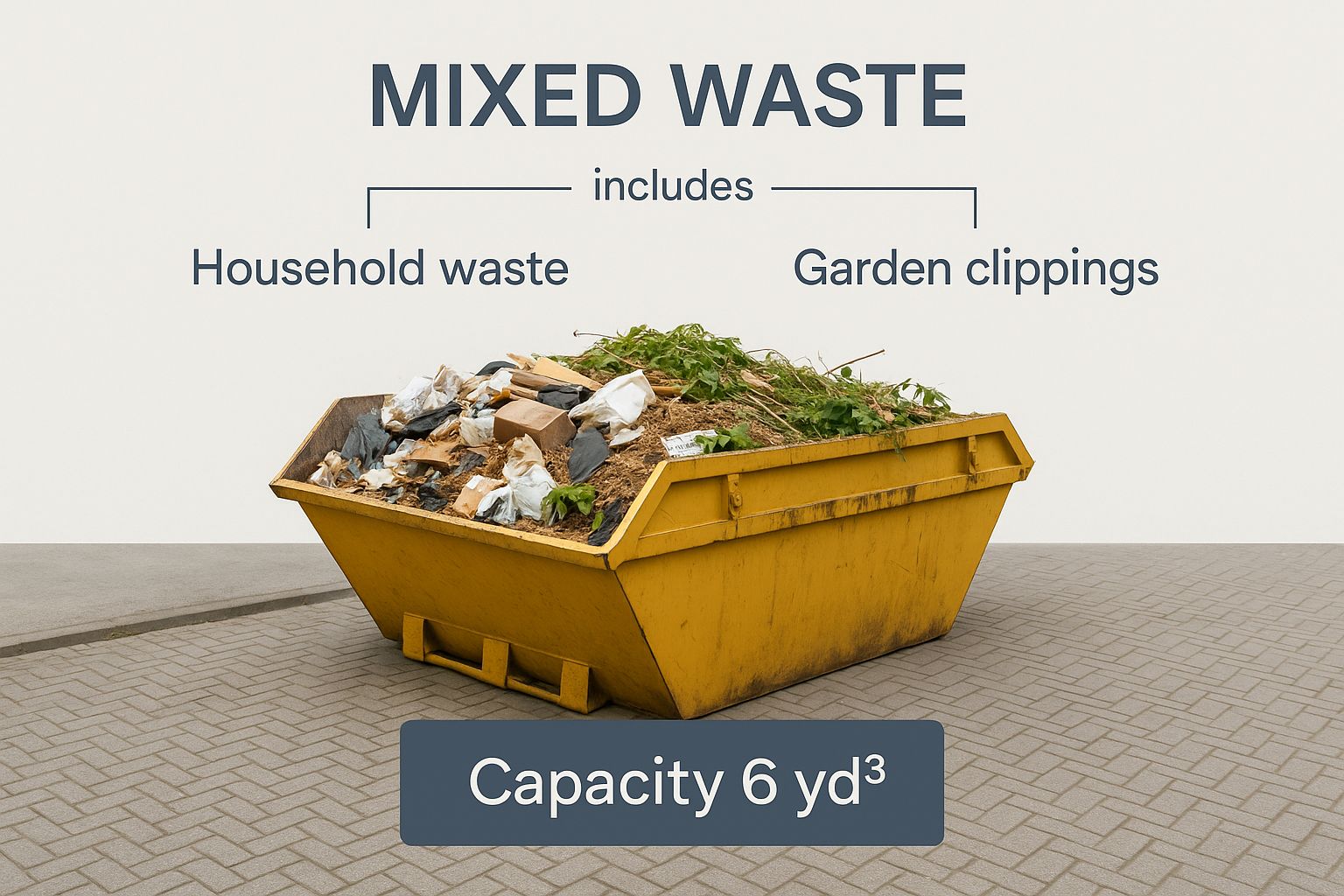
As you can see, its generous volume makes it a really practical choice for a huge range of medium-sized domestic projects.
The Critical Role of Weight Limits
Volume is only half the story; weight is the other crucial piece of the puzzle. While a 6-yarder offers plenty of space, you absolutely have to consider how heavy your waste materials are. A skip filled with lighter stuff like timber and plasterboard will weigh far less than one packed with dense materials.
It's a common mistake to think that if there's still space, you can keep loading. Heavy waste like soil, bricks, or concrete can quickly push you over the legal weight limit for the collection lorry, even if the skip isn't full to the brim.
Here’s why this matters so much:
- Heavy Materials: Soil, rubble, and concrete are incredibly dense. You can usually only fill a 6-yard skip part-way with these materials before hitting the weight limit.
- Lighter Waste: Things like old furniture, wood, and garden waste are much lighter, letting you use the full volume of the skip.
Trying to decide between different sizes can be confusing, but our guide on what size skip you might need offers more helpful advice.
On average, a typical small-to-medium house clearance or refurbishment produces an estimated 3 to 5 tonnes of waste. This amount fits comfortably within both the volume and weight limits of a 6-yard skip, making it one of the most efficient choices for UK domestic projects.
Ideal Projects for a 6 Yard Skip
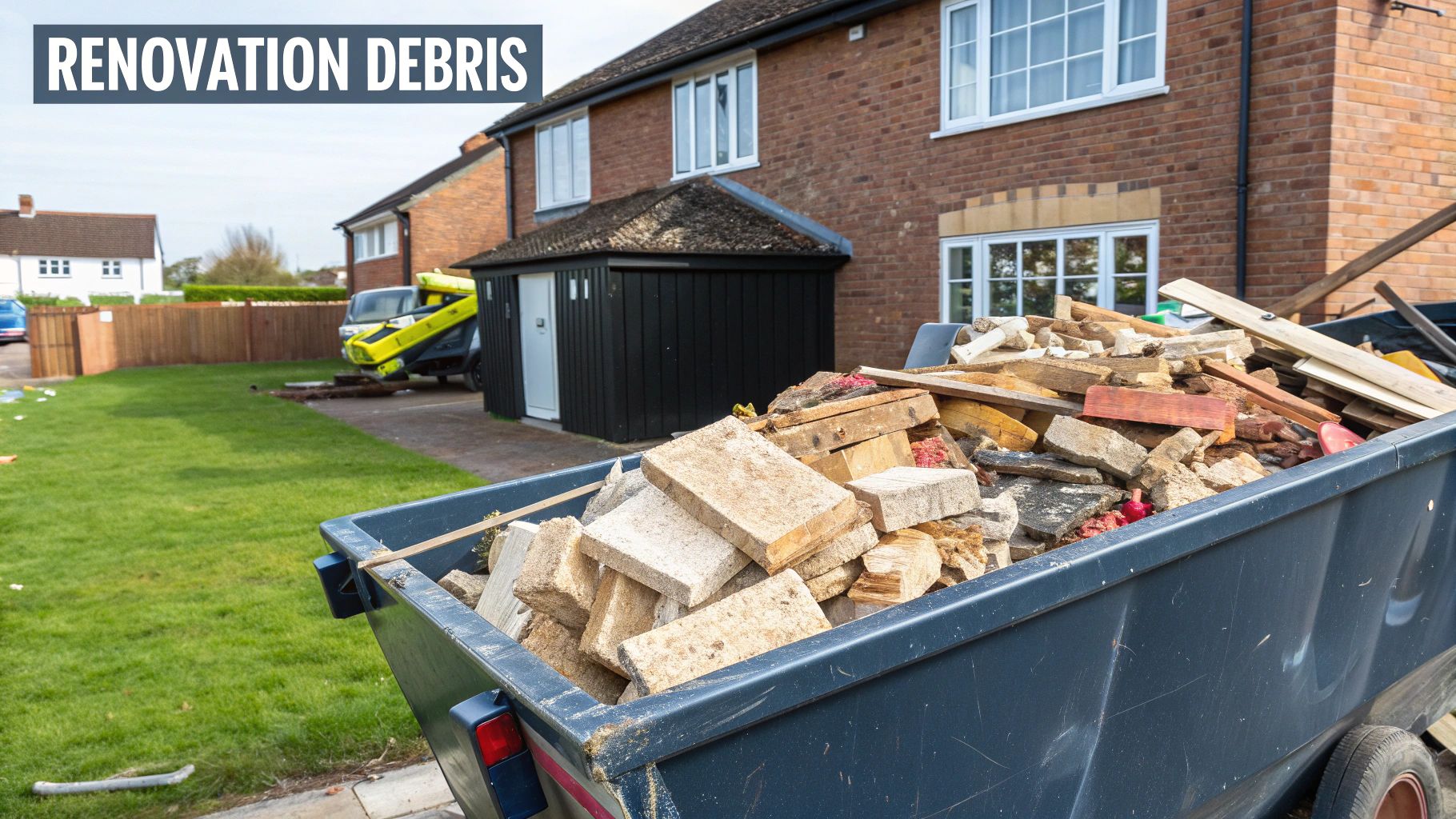
So you've got a good picture of the skip's size and what it can hold, but is it actually the right one for your job? There's a reason the 6-yard skip is nicknamed the 'builder's skip' – its sheer versatility makes it a perfect fit for all sorts of medium-sized tasks.
The best way to decide is to see how its volume stacks up against real-world projects. This is key to avoiding those classic mistakes: either ordering a skip that’s too small and having to pay for a second one, or getting one that’s too big and wasting money on empty space.
Common Domestic and DIY Jobs
For homeowners and DIY fans, the 6-yard skip is often the ideal partner for those more substantial projects that create a mix of bulky items and heavy rubble. It's built to handle the debris from jobs that are way too big for your regular council bin collections.
You’ll find it’s just the ticket for projects like these:
- Complete Bathroom Remodels: Easily swallows an old bath, shower screen, toilet, sink, plus all the old tiles and flooring.
- Medium Kitchen Rip-Outs: Has more than enough room for old worktops, cabinets, appliances, and all the packaging from the new units.
- Significant Garden Landscaping: Perfect for getting rid of soil, turf, old paving slabs, broken fence panels, and other green waste.
- House or Garage Clear-Outs: Ideal when you're getting rid of old furniture, carpets, and general clutter from a medium-sized property before a move.
For bigger home renovations or demolition projects, a 6-yard skip can still handle a serious amount of waste, though you might need to plan for multiple skips if you're doing a full house strip-out.
Small-Scale Commercial and Trade Use
It's not just for jobs around the house; the 6-yard skip is a firm favourite on smaller building sites, too. Its relatively compact footprint means it can be dropped on-site without causing a major obstruction, while still offering enough capacity for a decent amount of construction waste.
For tradespeople, the 6-yard skip strikes an ideal balance. It's large enough to hold waste from several days' work on a small extension or renovation, but small enough to be manoeuvred into tight residential streets where larger skips simply won't fit.
This adaptability makes it a really cost-effective and practical choice, helping you manage waste efficiently without letting it overwhelm the site.
Right, you've got the size of the 6-yard skip figured out, but what about the practical stuff? Let's talk money and rules, because getting this part right is just as important as knowing what you can fit inside.

The cost to hire a skip isn't a one-size-fits-all deal. It can change quite a bit depending on where you are in the UK, what you're throwing out, and how long you need the skip for.
As a ballpark figure, a 6-yard skip will typically set you back somewhere between £195 and £200. But remember, this is just a guide. Prices can swing based on your specific postcode and the type of waste, so it's always smart to get a direct quote for your job.
Where Can I Put My Skip?
This is a big one, and it directly affects the cost and paperwork involved. If you've got space on your own private land, like a driveway, you're golden. Just have the skip dropped off there, and you're good to go.
But what if it needs to go on the street? If any part of the skip has to sit on a public road, pavement, or even the grass verge, you'll need a skip permit from your local council. This isn't just a bit of red tape; it's a legal must-have to keep things safe and accessible for everyone.
Good news, though – your skip hire company will almost always sort out the permit application for you. They’ve done it a thousand times and know exactly what the local council needs. Just be aware that this will add to the final cost and you'll need to give them a few days' notice to get it all arranged.
So, What's Involved with a Permit?
Getting a permit is a straightforward process, but it has a few key parts to ensure everything is above board:
- The Application: Your skip provider handles all the paperwork and submits it to the council on your behalf.
- Extra Cost: The fee for the permit varies from one council to another, but it will be added to your total hire bill.
- Safety First: If the skip is staying on the road overnight, it must have safety lights and traffic cones around it.
Following these steps makes sure your project goes off without a hitch and you stay on the right side of the local regulations. To get a more detailed breakdown of what goes into the price, take a look at our guide on how much skip hire costs.
Common Questions About 6 Yard Skips
Even when you've done all your research, a few last-minute questions always seem to crop up just before you hire a skip. Getting these sorted can be the difference between a project running like clockwork and one that’s a bit of a headache.
This is your final checklist for a hassle-free hire. We'll cover everything from what you can't throw away to how to load your skip like a pro, helping you sidestep those common pitfalls.
What Can I Not Put in a Skip?
While a 6-yard skip is a fantastic workhorse for a huge range of waste, there are strict rules about what's not allowed. These items are forbidden for very important safety and environmental reasons and need specialist disposal.
You absolutely cannot put the following items into a standard skip:
- Hazardous Materials: This is a big one. It includes asbestos, paint tins (unless they're completely empty and dry), solvents, oils, and gas cylinders.
- Electrical Equipment (WEEE): Anything with a plug or a battery is a no-go. Think fridges, TVs, computer monitors, and microwaves.
- Upholstered Furniture: Due to recent regulations on Persistent Organic Pollutants (POPs), things like sofas, armchairs, and upholstered office chairs must now be handled separately.
- Other Restricted Items: Batteries, tyres, and fluorescent light tubes are also on the banned list.
If you include any of these items, the driver might refuse to collect the skip, or you could face extra charges to cover the cost of proper disposal. If you're ever unsure about an item, it's always best to give your hire company a quick call.
How Can I Load a Skip Efficiently?
Getting the most out of every inch of your 6-yard skip is all about loading it smartly. A little bit of strategy goes a long way and can help you fit in far more than you'd expect, saving you both time and money.
The golden rule of skip loading is to start with flat items, break down anything bulky, and then fill the gaps as you go. Think of it like a game of Tetris – the goal is to leave as little empty space as possible.
Follow these simple steps for the perfect load:
- Start Flat: Begin by laying flat items like doors, old plasterboard, or fence panels at the bottom. This creates a solid, level base to build on.
- Break It Down: Dismantle everything you can. Taking apart old wardrobes, bookcases, and even large cardboard boxes makes a massive difference to how much space they take up.
- Add Heavy Items: Place heavier materials like soil or rubble around the edges. Just try not to concentrate all the weight in one spot.
- Fill the Gaps: Use all the smaller bits of waste and loose debris to fill in any remaining pockets of air.
What Happens If I Overload It?
Overfilling your skip is a serious no-no. Every skip has a clearly marked "fill line" running along its sides, and you must not load any waste above this level. This isn't just a guideline; it's a critical safety rule.
An overloaded skip is a real hazard on the road, as loose items can easily fall off and cause accidents. For this reason, drivers are legally forbidden from collecting a skip that has been filled past the level load line.
If they arrive to find it overloaded, they will have to refuse the collection, which usually means you'll be hit with a wasted journey charge. You'll then have to unload all the excess waste before they can return to collect it, causing delays and extra costs for your project.
For straightforward and reliable skip hire in Dorset, The Waste Group has you covered. We ensure you get the right skip for your project with transparent pricing and expert advice. Book your 6-yard skip online today or give our team a call to discuss your needs.
